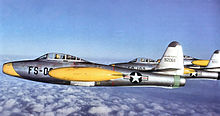|
87th Troop Carrier Group
The 87th Troop Carrier Group is an inactive United States Air Force unit. It was last assigned to the 87th Troop Carrier Wing at Atterbury Air Force Base, Indiana where it was inactivated on 1 February 1953. The group was first activated as the 87th Pursuit Group in 1942 at Selfridge Field, Michigan, but was inactivated almost immediately because the Army Air Corps had exceeded the number of pursuit units authorized, and the group was disbanded five days after it was activated.[1] It remained in this state until 1979 when it was consolidated with the 87th Troop Carrier Group in inactive status. In the fall of 1943, a new unit, the 87th Fighter Group was activated at Richmond Army Air Base, Virginia to serve as a replacement training unit. It served as a Republic P-47 Thunderbolt replacement training unit under First Air Force until 1944 when it was disbanded in a general reorganization of Army Air Forces training units. In 1949, the group was reactivated in the Air Force Reserve and served as a corollary unit of the active duty 27th Fighter Group and later, as the 87th Fighter-Escort Group, of the 12th Fighter-Escort Group until it was ordered to active service in 1951. Its personnel were used to man active duty units and the group was inactivated two months after being called up. The group was redesignated in 1952 as the 87th Troop Carrier Group, and activated at Atterbury Air Force Base to replace the 923d Reserve Training Wing. the following year the group was inactivated and replaced at Atterbury by the 434th Troop Carrier Group. HistoryWorld War II87th Pursuit GroupShortly after the Japanese Attack on Pearl Harbor, as the Army Air Corps was expanding, Third Air Force activated the 87th Pursuit Group at Selfridge Field, Michigan. However, the group was disbanded almost immediately because the Army Air Corps had exceeded the number of pursuit units authorized, and the group was disbanded five days after it was activated. The same happened to the 304th, 305th, and 306th Pursuit Squadrons that had been assigned to the group[1] The pursuit group remained disbanded until 1979 when it was consolidated with the 87th Troop Carrier Group in inactive status.[citation needed] 87th Fighter GroupThe 87th Fighter Group was activated the following year at Richmond Army Air Base[1] with the 450th,[2] 535th,[3] 536th,[4] and 537th Fighter Squadrons[5] assigned. The group began operations with Republic P-47 Thunderbolts as a Replacement Training Unit (RTU). RTUs were oversized units which trained aircrews prior to their deployment to combat theaters and assignment to an operational group.[6] In January 1944, the group began a split operation when group headquarters and the 450th and the 535th squadrons moved to Camp Springs Army Air Field, Maryland,[1][2] and the remaining squadrons transferred to Millville Army Air Field, New Jersey.[4][5] The 450th Squadron did not become operational until the move to Camp Springs.[2] However, the Army Air Forces found that standard military units, based on relatively inflexible tables of organization were proving less well adapted to the training mission. Accordingly, a more functional system was adopted in which each base was organized into a separate numbered unit.[7] while the groups and squadrons acting as RTUs were disbanded or inactivated.[8] This resulted in the 87th, along with the 450th Squadron at Camp Springs, being disbanded in the spring of 1944[1] and being replaced by the 112th AAF Base Unit (Fighter), which assumed the group's mission, personnel, and equipment.[9] The 535th was replaced by the 125th AAF Base Unit (Fighter),[10] and the two squadrons at Millville were rolled into the 135th AAF Base Unit (Fighter).[11] Air Force Reserves The group was reactivated in 1949 in the Air Force Reserve at Bergstrom Air Force Base as a corollary unit to Strategic Air Command's 27th Fighter Group with one operational squadron and two support units.[1][12] With no aircraft assigned, reservists of the unit flew the North American F-82 Twin Mustangs, and later, the Republic F-84 Thunderjets[13] of the 27th. When most of the 27th group deployed to Korea for the Korean War, the group became affiliated with the 12th Fighter-Escort Group. The group was called to active service in May 1951. After its personnel were used to man other units, the group was inactivated in June.[1] In 1952 the group was redesignated as the 87th Troop Carrier Group, and assigned to the newly constituted 87th Troop Carrier Wing under the wing base organization system and activated at Atterbury Air Force Base. The 87th wing replaced the 923d Reserve Training Wing at Atterbury when reserve flying operations resumed there.[14] The group operated a mix of aircraft to train reservists. In February 1953 the 434th Troop Carrier Group was released from active duty and activated in the reserves, assuming the mission, personnel and equipment of the group.[15] Lineage87th Pursuit Group
87th Tactical Airlift Group
Assignments
Components
Stations
Aircraft
ReferencesNotes
Bibliography
Further reading
|
||||||||||||||



